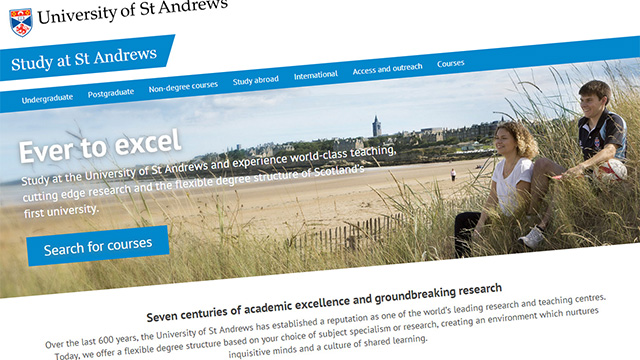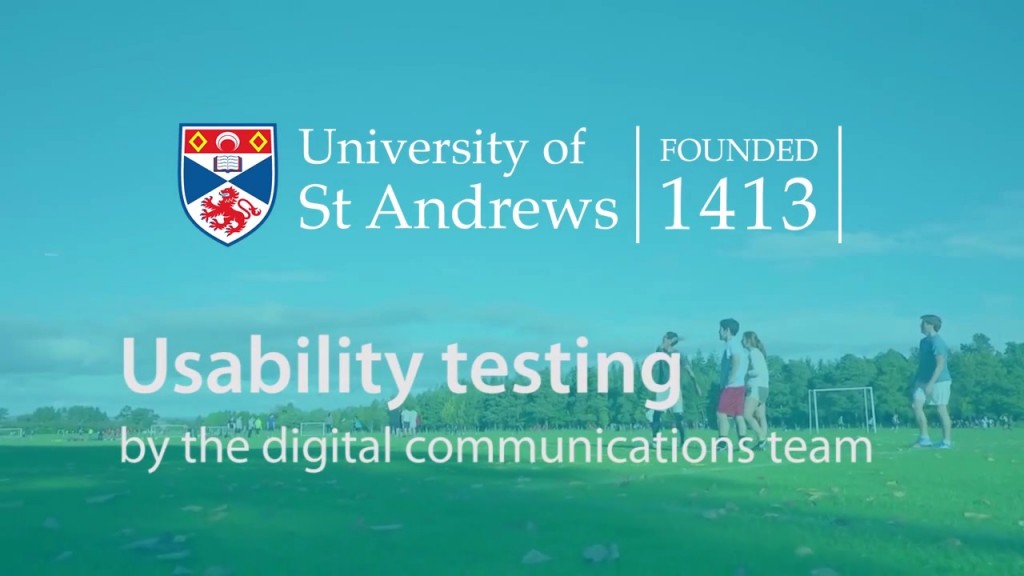Why is the user important?
As we may have mentioned a few times already, the digital communications team is committed to a user centred approach to our work: whether that be research, design, content or build. We have placed users at the heart of the decisions we make, which is, in some areas, a radical departure from the way that the University website was managed before. In this post, I want to outline why it is that we believe it is so important to create from the user’s perspective.
The website is a tool to help the institution achieve its objectives
The first hurdle we must jump is in how we see the University website. It’s tempting to see it as something valuable in and of itself. But in our eyes, it’s not. The website’s value lies in it’s ability to help the institution do certain things, to achieve our objectives. Our website is a communications channel, a home for information and documents, a tool.
If the website is there to help the institution achieve its objectives, we must first know what the institutional objectives are. We know that at a high level, the University aims to provide excellent teaching, globally recognised research, a great student experience, good links with the local community and to maintain its reputation.
Next, departments and units start to look at how we can achieve these objectives. Admissions works on recruiting the best and brightest students, and providing access to students from all backgrounds. Schools and research units are planning their research and inviting key researchers to join their projects. Across the University, staff are working to provide students with world-leading learning opportunities, extracurricular opportunities, and support in all of their needs.
It’s the role of the digital communications team to understand what the institutional objectives are, and how our colleagues are working to meet them – and then to offer up ways in which digital channels could help. Whether that’s creating new webpages for a research project or advising on social media for an admissions campaign, we understand how digital can support and further the aims of the University. Here, it’s easier to see how the website is something functional, rather than something inherently valuable.
What users want to do versus what we want users to do
In order to meet our institutional objectives, we want certain people, or groups of people, to do specific things. For example; if our institutional goal is to recruit more students, what we really want is for more prospective students to apply to the University, and more of the students who are offered a place to accept their offer to study at St Andrews. How can we use digital to encourage this?
The next hurdle we face is in recognising that in order for users to do the things that we want them to do, they have tasks that they need to complete, often in a specific order.
Think about a prospective student: Admissions would like them to apply to study here, and then accept their offer if they receive one. But the prospective student has a journey to go through before they reach that point. They’re investigating the courses we offer and the entrance requirements for them, the cost of tuition at St Andrews versus elsewhere, information about scholarships and accommodation, of sports and social activities and student support. They’re trying to make up their minds about whether to study here. This is where the digital communications team can work with Admissions, to ensure that the questions that a prospective student has are answered on the website, and that they can be found in an intuitive place.
This may sound simple, but it’s vitally important. If we do not make it easy for the user to complete the tasks that they need to complete, they are less likely to do the things we want them to do. If we cannot provide prospective students with fast access to our course listings or scholarship information or accommodation options, then the likelihood that they will choose to study here is reduced. If we help users do what they want to do, they are far more likely to do what we want them to do.
What users want
If providing what the user wants makes them more likely to do the things we want them to do, it makes sense to put the user at the centre of our decision making process. If we can meet their needs, then we’re a good way on the journey to meeting the institution’s objectives – only it isn’t quite that simple.
Figuring out what a user’s needs are is hard. It’s not as simple as just asking them – because users aren’t always honest about their preferences. In the words of one report,
“Ask readers what they want, and they’ll tell you vegetables. Watch them quietly, and they’ll mostly eat candy.”
Instead, we have to first understand the situation a user is in when they’re online. To start with, users are task-driven. When they visit a website, they’re normally looking for a specific piece of information. They are just want to do the thing they came to do as quickly as possible. Anything that distracts the user from their task may cause them to become frustrated and leave the website entirely.
In addition, while online, users have access to an almost infinite amount of information at all times. As such, they’re easily distracted. We need to ensure that we anticipate what a user will need and provide it in an intuitive fashion.
Using the web also often tends to be an uncomfortable experience. Users will typically be reading from a backlit screen, using a keyboard and mouse that may cause a repetitive strain injury, and sitting at an uncomfortable desk. Our job as web content designers is to help the user find the information they are looking for as quickly and easily as possible.
How can we find out what users really want?
So how do we establish what a user wants? What do we mean when we say that we design from a user’s point of view?
We start by throwing out all assumptions. Past experience and recent usability testing with real users has reaffirmed to us that often users do not do what we expect them to. Rather than starting with a belief that we already know what a user wants, we start with research.
Research usually means data from analytics software – primarily Google Analytics – which is installed across the University website and can show us how many users are viewing pages, how long they’re spending there, where they came from and they’re going next. (This is just a fraction of what Google Analytics does – but that’s a blog post of its own!)
We also undertake usability sessions with real users, which allows us to observe and record what they do, and also explain why they’re doing it. These sessions allow us to plan and amend our work as we go, ensuring we create the right solution.
Finally, we ask the content knowledge holders what information their users need to know. We do this last, because it allows us to build a picture of the user journey as it is, rather than as the department or unit think that it is. From this, we can understand which parts of the user journey are vital to the institution, as well as which parts are of most importance to the user.
This is why we don’t structure the website the same way the organisation is structured. Even people with a strong knowledge of how the University works do not know everything about each department’s responsibilities. Users know little and care even less about our internal silos. They just want to get to the information, so we structure the information in a way that users will understand.
It’s not just digital
So why do we put the user at the heart of all of our projects? Because meeting the user needs helps us meet the institutional needs. Not meeting the user needs quickly and intuitively is effectively sending our users to our competitors. Having a user centred approach just makes sense – and not just in terms of digital projects.
At the IWMW conference that Duncan attended last year, he heard a talk about user experience. In his blog post summary, he wrote:
“This talk provided a reminder that the website usability is just a small part of the overall user experience. He cited Jared Spool, who pointed out that the user experience can be ruined by a bad face-to-face interaction, no matter how good the website usability is.”
A user-centred approach isn’t something that’s only useful for the digital communications team; it’s something we’re championing across the University.

